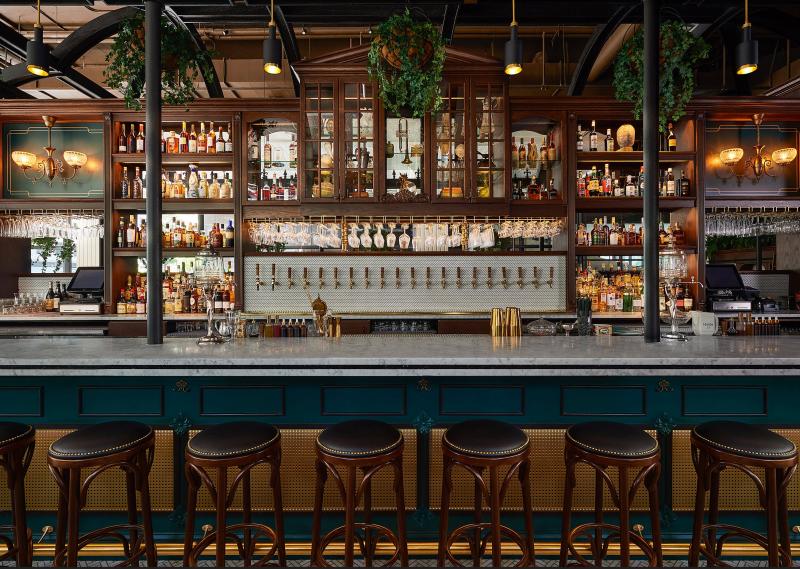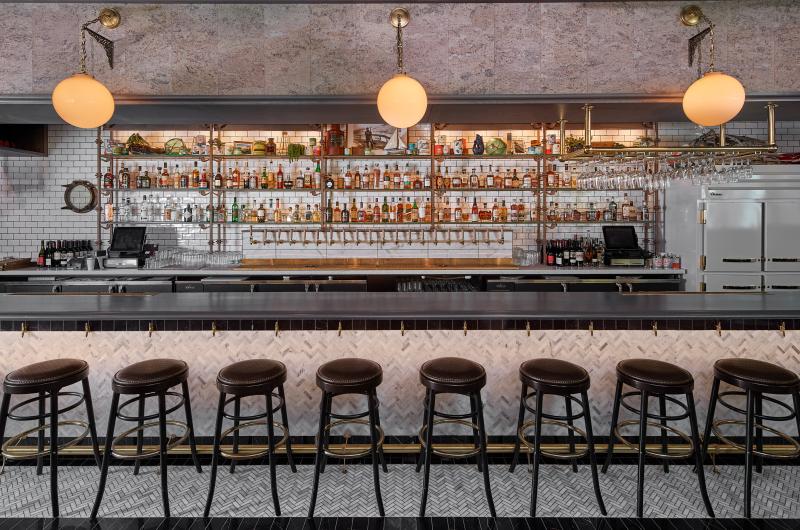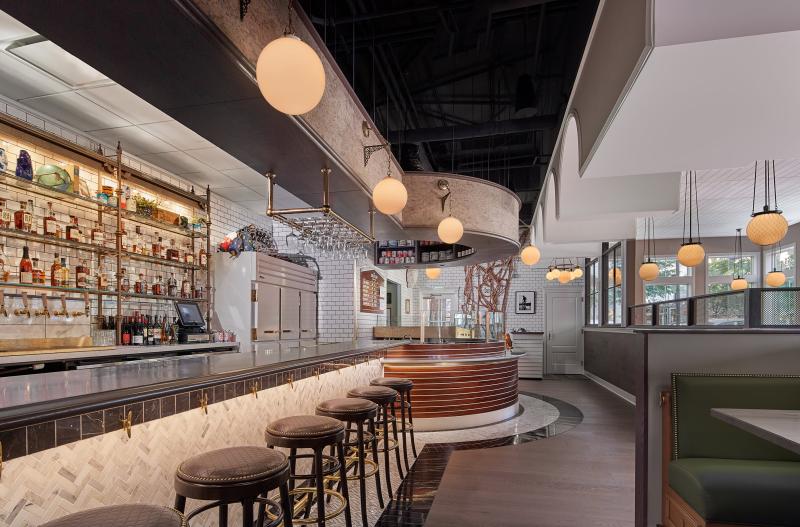Nobody likes being in a cramped, uncomfortable space – especially if you’re a bartender who’s constantly receiving a barrage of food and drink requests.
Ensuring that staff have an organized bar space – designed to work for and not against them – is paramount and crucial to a bar’s success.
Those specific design decisions that you make early on – the overall look, the materials chosen, function and flow, cleanability and durability, the social elements woven throughout, etc. – should all be included in your design to provide the best user experience possible for bartenders and guests alike.
So, if you’re currently strategizing about designing or re-designing an efficient, beautiful bar space, here are the six key design guidelines to consider – all of which should be top of-mind during the process.
1. The Overall Look
Drawing people into a bar is difficult but developing the secret sauce that encourages guests to stay for more than one drink is a completely different beast.
Really focusing on those “wow moments” – such as a backlit bottle display or playing with height variations – is critical, and those strategic integrations help to keep all eyes (and heads) pointed inward.
Creative visual aspects work to increase guest engagement so they keep their tabs open a little longer. This strategy also allows bartenders more freedom to move around the bar and help additional guests while simultaneously boosting the bar’s profit margins.

(Photo by: Kristopher Ilich / Courtesy of Dauphine's )
2. Function
Considering the designers aren’t the ones who will be using the bar as a daily workspace, it’s always smart to get feedback and insights upfront from the bartenders and staff who’ll be using the space. In fact, you should also get feedback from the bartenders a few weeks after the bar has opened or had a trial run. You want to see how the space is flowing and make any last-minute adustments.
Gaining insights from the bartenders and staff who will be utilizing the space – and placing yourself in their shoes – helps streamline the design process, allowing function and form to be layered seamlessly. Having easy access to glassware, cocktail ingredients and even refrigeration units makes a big difference to bartenders on a busy night. Hidden storage spaces and built-in alcoves for step-stools are also a big plus for smoother functionality.
3. Cleanability and 4. Durability
Bars are prone to messiness. With the amount of foot traffic received, drinks made and miscellaneous items dropped in one night, owners aren’t expecting to turn on the lights to a spotlessly clean space. Knowing that bars and bar tops specifically see a little more wear and tear than other furniture pieces, using durable materials that are easy to clean will save bar owners and operators a lot of trouble in the long run.
For example, wood tops will soak up any moisture – water and spirits – and become soft. Not only will the wood begin to smell, but it will also crack and splinter if not sealed properly with a nice catalytic varnish. Polished and sealed stones are durable countertop options that wipe clean. Just polished stones can be cold to the touch, but left to age for a month or two, they develop an attractive patina.
Behind the bar, a lot of liquids, ice and glass fall to the ground, making slip-resistant flooring a must. Concretes or vinyls that are easy to sweep and mop work best in these spaces.
Designers are also sometimes wary of designing bars using high-end materials because they want to make sure each element will be taken care of. What’s the point of curating a luxurious space if it won’t be cleaned properly? One key element where designers can potentially save in this case is on the barstools. If bartenders must move them every night to clean, then stackable, lighter stools are a favorable option.

(Photo by: Kristopher Ilich / Courtesy of The Salt Line Ballston)
5. Social Nature
Bars are great in the sense that they’re abundant and inclusive. A group of friends looking to have a fun night out, a pair going on their first date, or even a married couple hoping to switch things up can all be found inside the same bar having some laughs and making new memories. A horseshoe-shaped bar, or at least a long bar with end caps, creates a necessary space for these special, sometimes romantic encounters to happen.
Developing spaces along the edge and around the bar itself helps keep the front cleared so guests can actually see the bartenders mixing drinks. Also, making total use of the space, big or small, allows the pathways and traffic patterns to be extended throughout the bar to avoid any dead-end situations.
6. Televisions
Another popular bar back element is televisions. Some enjoy going to bars to catch the game on a larger screen, while others want to go out and meet people for a more social experience. Many owners feel that TVs are a must, so finding clever ways to integrate them without compromising a more high-end feel is crucial. So, they’re not front and center, try to tuck them away or mount them higher on the wall so they’re out of direct eyesight. In tighter spaces, sliding or hinged doors can help hide them away when not in use. Playing custom slideshows or digital art on the TV when games aren’t on can be a unique twist, too, but make sure the bartenders know where the remotes are located and how to control the devices so they don’t become a distracting, detracting element.

(Photo by: Kristopher Ilich / Courtesy of The Salt Line Ballston)
Griz Dwight, AIA, LEED AP, is the principal and owner at GrizForm Design Architects, located in Washington D.C. The firm, founded in 2003, is a leading hospitality architecture and design studio with award-winning work and a team who prides itself on its craftsmanship, strong attention to detail, awareness of historical context, and innovation. GrizForm – which has been featured in the Wall Street Journal, Interior Design, Hospitality Design and Boutique Design – produces creative solutions for its clients, including fresh design concepts, forward-looking ways to solve industry-related problems, and innovative approaches to push the design envelope further by incorporating unique materials or subtle historical references. To learn more, visit GrizForm.com.
Plan to Attend or Participate in
Bar & Restaurant Expo, March 27-29, 2023
To learn about the latest trends, issues and hot topics, and to experience and taste the best products within the bar, restaurant and hospitality industry, plan to attend Bar & Restaurant Expo, March 27-29, 2023 in Las Vegas. Visit BarandRestaurantExpo.com.
To book your sponsorship or exhibit space at Bar & Restaurant Expo, contact:
Veronica Gonnello
(for companies A to G)
e: [email protected]
p: 212-895-8244
Tim Schultz
(for companies H to Q)
e: [email protected]
p: (917) 258-8589
Fadi Alsayegh
(for companies R to Z)
e: [email protected]
p: 917-258-5174
Also, be sure to follow Bar & Restaurant on Facebook and Instagram for all the latest industry news and trends.
